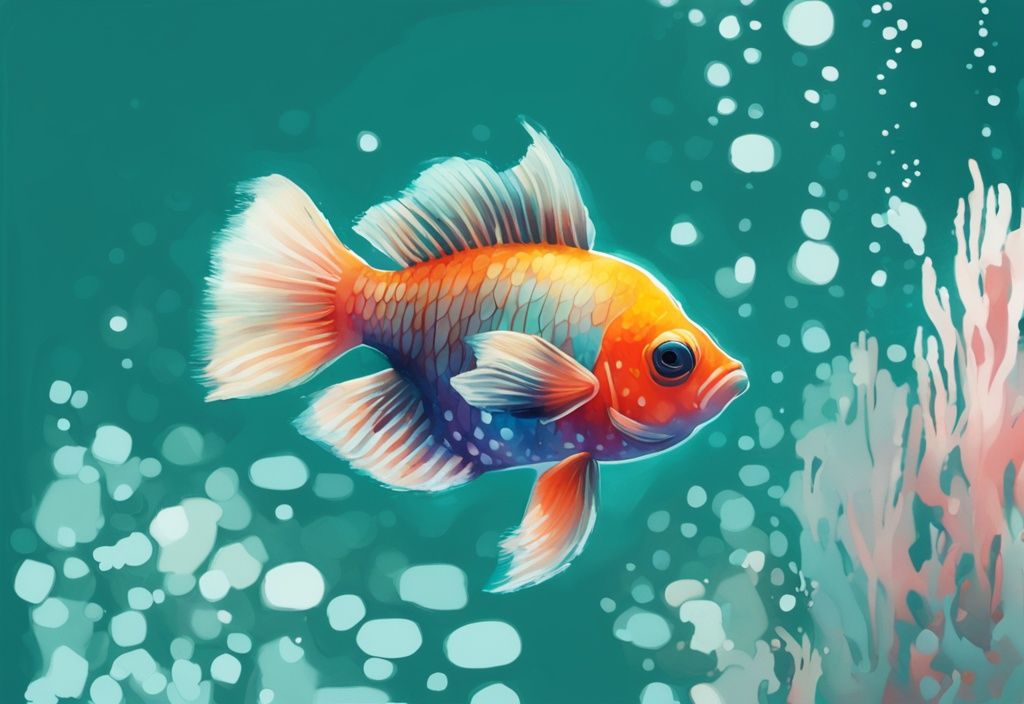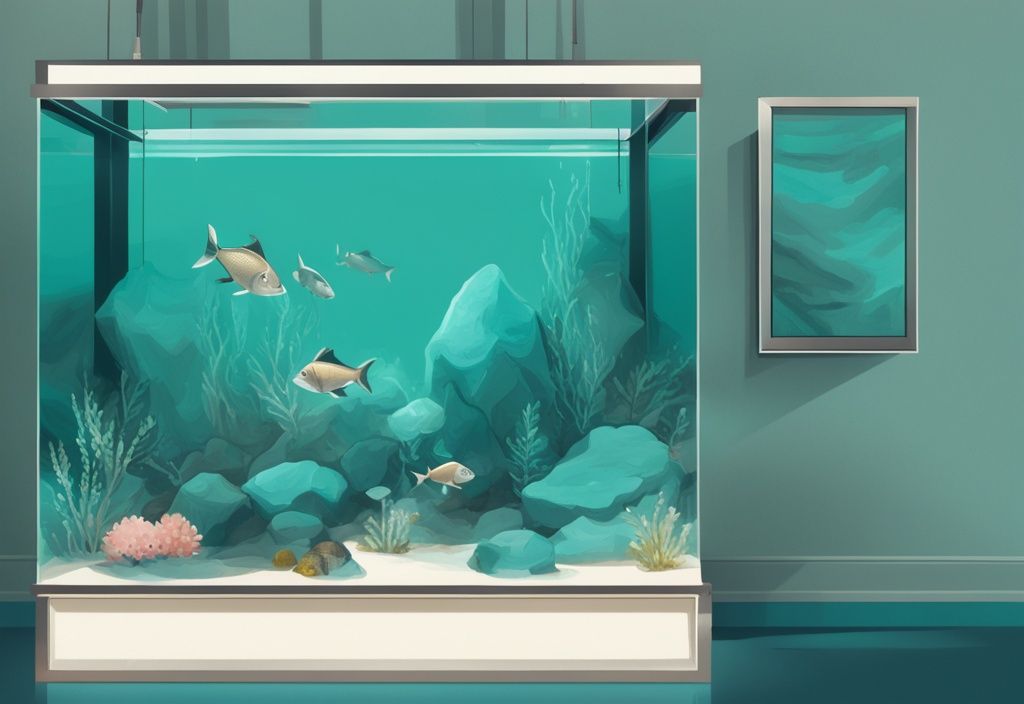Ever puzzled over mysterious white spots on your fish tank glass? I’m Dr. Melanie Rivers, and as a long-serving marine biologist, I’ve dealt with this far more than you can imagine. These seemingly innocuous spots can be a red flag to various concerns from simple limescale build-ups and nerite snail eggs, to worrying fungal or bacterial issues. But worry not! Addressing these issues can be easier than you think.
In this article, we’ll walk through the labyrinth of these white spots’ causes, helping you to identify the culprit behind your aquarium blotches. With a bit of professional insight, you’ll soon pick out whether it’s a harmless mineral deposit or something more concerning you’re dealing with.
The cherry on top? We’ll navigate the pool of remediation methods, so you can bring back that crystal clear, healthy aquarium you crave. The path to a perfectly pristine fish tank is merely a read away. So, let’s dive in!
Overview of White Spots on Fish Tank Glass
White spots on fish tank glass are a common issue faced by many aquarium enthusiasts. These spots can suddenly appear, sparking concern due to their implications for tank health. With various potential causes, each source demands specific identification and treatment methods.
One prevalent cause of white spots on fish tank glass is nerite snail eggs. These algae-eating snails often lay small, white, sesame seed-like eggs on glass surfaces. Despite their challenge to remove due to a hard texture, these eggs are harmless to fish. However, their persistent presence can detract from the aesthetic appeal of the aquarium.
Fungal or bacterial blooms can also manifest as white spots on fish tank glass. These tiny, grain-like dots can cling to glass, plants, and other tank inhabitants. Such blooms may indicate overfeeding, poor water quality, or sudden changes in tank temperature. Introducing new fish from infected environments can also bring these blooms, posing a potential health risk to aquatic pets if not treated promptly.
Limescale build-up is another contributor to white spots on fish tank glass. This white residue, composed of calcium carbonate, forms when hard water evaporates, leaving mineral deposits behind. Although limescale is harmless to fish, it can obscure the tank’s clarity and make the glass appear dirty, thus obstructing the view of your aquarium.
Additionally, common pests such as spirobid worms can be the culprits behind white spots on glass. These harmless filter feeders appear as tiny white dots, often in new tank setups. If you’re dealing with this issue, you might want to learn more about cleaning your fish tank effectively. Despite their small size, regular cleaning can easily remove them.
Understanding the various causes of white spots on fish tank glass is essential for proper maintenance. Regular monitoring and prompt intervention help maintain a clean tank and healthy fish.
Potential Causes of White Spots on Fish Tank Glass
Nerite Snail Eggs
Nerite snails, renowned for their algae-eating prowess, often bring a side effect for tank owners—white spots on glass and decor, resembling tiny sesame seeds. These are actually nerite snail eggs, notorious for their hardness, making them a challenge to scrape off. When nerite snails are newly introduced, they tend to lay eggs in abundance. Fortunately, this behavior usually declines over time. As the eggs age, they soften and become easier to remove, often falling off with minimal effort.
Effects of Spirobid Worms
Spirobid worms are harmless little filter feeders that frequently appear in newly established aquariums. These creatures show up as minuscule white dots on various surfaces, including glass, overflow boxes, sumps, and return pumps. Although their initial presence may be alarming, they usually disappear naturally as your tank matures. Removing spirobid worms is simple with an algae scraper, making this a minor and manageable issue.
Limescale Build-Up
Limescale build-up is common, especially in regions with hard water. This white residue, composed of calcium carbonate, forms when water evaporates, leaving mineral deposits on the glass. While limescale doesn’t harm fish, it can significantly obstruct the clarity of your viewing panels, diminishing your enjoyment of the tank. Think of it as similar to the deposits you might find on your showerhead in a hard water area.
Fungal or Bacterial Growth
Fungal and bacterial growths can manifest as small, grain-like dots on the glass, plants, and even tank inhabitants. These blooms can occur due to various reasons such as overfeeding, poor water quality, or sudden temperature shifts. Additionally, introducing new fish from infected tanks can transport these issues into your aquarium. Recognizing and treating these growths promptly is vital to safeguard your tank’s ecosystem. Routine monitoring and maintaining optimal water conditions can greatly reduce the risk of such outbreaks, fostering a healthier environment for your fish.
Detecting & Identifying White Spots on Your Aquarium
The process of detecting and identifying white spots on fish tank glass is crucial for maintaining a healthy aquarium environment. These spots can indicate various underlying issues that need addressing to ensure the wellbeing of your aquatic life. From snail eggs to bacterial growth, each type of white spot has unique characteristics and implications.
Characteristic Appearance of White Spots
White spots on fish tank glass can manifest in various forms.
They might look like tiny specks of white dust, small grain-like dots, or even resemble sesame seeds. These spots often appear suddenly and can cluster in groups, making them more noticeable against the transparent glass.
Spots that resemble tiny seeds are frequently due to snail eggs, particularly from species like nerite snails. These eggs are hard and opaque, attaching firmly to the glass and other surfaces within the tank. Over time, if they do not hatch, the eggs soften and can be more easily removed.
In some cases, what seems like minuscule dandelion seeds might appear attached to your glass. This can indicate the presence of hydra, a type of small, freshwater organism. Hydra tend to remain stationary, unlike other small aquatic creatures such as daphnia, which are in constant motion.

It’s also possible that these white specks signify bacterial or fungal growth, especially if they appear as small, grainy dotted clusters. These can cling tenaciously to the glass as well as to plants and tank inhabitants. Often, they are precipitated by factors like overfeeding, poor water quality, or the introduction of new fish carrying infections.
By closely observing these white spots—including their shape, size, and behavior—you can more accurately determine the underlying cause. Movement can be a key differentiator: if the white specks are moving, they are likely organic and alive, such as daphnia. In contrast, stationary spots might be non-living elements like limescale or dead snail eggs. This observation is crucial for deciding the appropriate action to maintain the health and clarity of your aquarium.
Proven Techniques to Remove White Spots from Fish Tank Glass
Maintaining a spotless fish tank can be a challenge, especially when mysterious white spots start appearing on the glass. These stubborn marks are often attributed to various factors, such as snail eggs, spirobid worms, limescale build-up, or fungal and bacterial blooms. The following sections offer detailed and practical solutions to address these persistent problems, ensuring your aquarium remains pristine. Additionally, incorporating house plants in your aquarium can enhance water quality and contribute to a balanced ecosystem.
Methods for Removing Snail Eggs
Nerite snail eggs are a common culprit behind white spots on fish tank glass. These hard-shelled eggs resemble tiny, white sesame seeds and can be problematic to remove. Gently use a flat, blunt tool like a chopstick to scrape them off the glass. Once dislodged, the eggs will fall to the substrate and degrade naturally, simplifying tank maintenance. Regularly scrubbing the glass and vacuuming the substrate are effective preventive measures to keep these sticky spots at bay.
Getting Rid of Spirobid Worms
Spirobid worms can create tiny white dots on your aquarium glass, especially in new setups. These harmless filter feeders can be managed by using an algae scraper or a similar tool to carefully scrape them off the glass and other affected areas like overflow boxes. Consistent tank maintenance and cleaning routines are essential to prevent the accumulation of these pests. Fortunately, spirobid worms typically disappear over time if the tank is kept clean.
Cleaning Solutions for Limescale
Preparation & Treatment
Limescale build-up commonly occurs in tanks with hard water, appearing as white streaks or crusty patches on the glass. Start by moving your fish to a temporary tank and draining the aquarium. Apply white vinegar to the affected areas and let it sit for 10-20 minutes. This will help break down the calcium carbonate deposits. Use a non-abrasive pad to carefully scrub off the softened residue. For more inspiration on enhancing your aquarium, check out our guide on 25 unique fish tank decorations.
Rinsing and Reinstating the Tank
After treating the limescale with vinegar, scrape off any remaining stubborn patches using a razor or algae scraper. Thoroughly rinse the tank to remove all vinegar residues, as any leftover vinegar can affect water quality. Once the tank is clean, refill it with fresh water and safely reintroduce your fish.
Tackling Fungal or Bacterial Blooms
Fungal and bacterial blooms may appear as small, grain-like dots clinging to the tank glass, plants, and inhabitants. These growths are often triggered by overfeeding, poor water quality, or sudden temperature changes. To manage these blooms, slightly increase the tank temperature to speed up the lifecycle of the parasites. Additionally, add aquarium salt and use over-the-counter treatments to combat the growth effectively. Regular water changes are vital for maintaining optimal water quality and preventing these blooms. Quarantine new fish before introducing them to your primary tank to avoid future infections.
Effective Prevention Measures for White Spots on Aquarium Glass
Maintaining a spotless aquarium requires dedication and attention to a few key principles. Understanding how to prevent white spots on fish tank glass is essential for every aquarist’s journey towards a healthy and vibrant aquatic environment.
Importance of Proper Water Quality
Maintaining optimal water quality is crucial in preventing white spots on fish tank glass. Regular water tests to monitor parameters such as pH, hardness, and alkalinity are essential. These tests help detect any imbalances that could stress your fish, potentially leading to issues like fungal or bacterial spots.
Use reliable testing kits and make a habit of recording the results to track changes over time. Consistent water parameters contribute to a stable environment, minimizing stress-induced problems and reducing the risk of white spot formation. Think of it as creating a pristine underwater world where your fish can thrive.
Best Feeding Practices
Proper feeding practices play a significant role in preventing white spots caused by bacterial or fungal growth. The aim is to avoid overfeeding your fish since leftover food decomposes, deteriorating water quality, and promoting harmful growths on the glass and other surfaces.
Feed your fish only what they can consume within a few minutes and make sure to remove any uneaten food promptly. This practice not only keeps the water clean but also reduces the likelihood of white spots developing from excess organic material. It’s similar to maintaining a balanced diet; it’s all about ensuring your fish receive the right amount of food without the leftovers causing trouble.
Regular Maintenance Practices
Routine maintenance is essential for a healthy and spot-free aquarium. Regularly clean the glass, decor, and substrate to remove any build-up of debris and prevent white spots from appearing. Use appropriate cleaning tools to gently scrub the glass and avoid scratching it.
Additionally, monitor the health of your aquarium plants and remove any decaying leaves or debris that could contribute to poor water quality. By inspecting for white spots frequently and addressing them promptly, you can maintain a pristine aquarium environment that promotes the well-being of your fish and plants.

Think of maintaining your aquarium like caring for a beautiful garden—the constant attention to the little details ensures the entire ecosystem stays balanced and vibrant. Regularly removing debris and decaying matter is as crucial as pulling weeds to keep your garden lush and healthy.
Identifying and Addressing Persistent White Spots on Fish Tank Glass
Advanced Identification Techniques
When tackling the stubborn issue of white spots on fish tank glass, employing advanced identification techniques becomes essential. Start with a magnifying glass to get a closer look at the characteristics of the white spots, as this tool can reveal finer details invisible to the naked eye. For a more nuanced analysis, consider using a microscope. This allows for a definitive examination of the organisms present, whether they are pests like spirobid worms or fungal spores.
Additionally, supplement your findings by comparing the visual characteristics of the spots with images and descriptions found in aquarium books or reputable online resources. Reliable sources include detailed guides and databases maintained by aquarium hobbyist communities or scientific institutions. This ensures that you can accurately identify the root cause of the problem, paving the way for effective treatment and maintaining your aquarium’s health.
Talking to Aquarium Professionals
If you continue to struggle with persistent or severe white spots on your fish tank glass, consulting aquarium professionals is a wise move. Veterinarians specializing in fish health can offer precise diagnoses and treatment plans tailored to your specific situation. They can also assess any potential health impacts on your fish and recommend effective treatments.
Not only veterinarians but also experienced aquarists and fish store experts can be invaluable resources. These professionals often possess extensive practical experience, offering insights based on hands-on knowledge. Their guidance can help you navigate complex issues that may not be covered in general literature. They can advise on best practices for prevention and maintenance, ensuring a healthy and vibrant aquarium environment.
Don’t hesitate to seek out professional help. Addressing white spots effectively requires a mix of accurate identification, appropriate treatment, and consistent preventive measures. By consulting experts, you’ll equip yourself with the knowledge and tools necessary to remedy the issue, thus safeguarding your aquatic ecosystem.
FAQ
When you spot white specks on your fish tank glass, it’s natural to have questions. Here’s a thorough breakdown of the most common queries, aimed at helping you understand and manage these pesky white spots in a way that ensures your fish thrive.
Can white spots on the aquarium glass harm my fish?
- Safe but Annoying: White spots from snail eggs or limescale are generally harmless to your fish. These can be easily cleaned and don’t pose a direct threat to the underwater residents.
- Potentially Dangerous: On the other hand, fungal or bacterial growth, and parasites like Ich can be harmful if left untreated. Timely intervention and proper tank maintenance are crucial in preventing these issues from impacting your fish’s health.
How to differentiate between snail eggs and limescale?
- Identifying Snail Eggs: Look for tiny, hard sesame seed-like spots clustered together. These are typical of snail eggs and are often seen attached to the glass or decorations within your aquarium.
- Recognizing Limescale: Limescale appears as white streaks or crusty patches on the glass, created by the evaporation of hard water deposits. Unlike snail eggs, these patches are usually more spread out and crusty to the touch.
Are there safe ways to clean my fish tank?
- Fish-Safe Solutions: Cleaning your tank effectively while ensuring the safety of your fish involves using fish-safe cleaning solutions or plain white vinegar. These options help disinfect without introducing harmful chemicals.
- Avoid Household Products: Refrain from using household cleaning products as they can be toxic to your aquatic life, potentially leading to severe health issues or fatalities.
- Proper Tools for Stubborn Spots: For those really tough spots, scrape them safely using appropriate tools specifically designed for aquarium use. Always ensure these tools are both gentle on the glass and effective in removing the unwanted residue.
What fish species can control pests in my aquarium?
- Natural Pest Controllers: Certain fish species, like Gouramis and Mollies, are excellent at controlling pests such as hydras within your tank. Including these species can naturally reduce minor pest issues.
- Consider Current Inhabitants: While regular tank inhabitants like White Cloud Minnows or Ghost Shrimp are beneficial, they might not tackle all types of pests. Their role is more about maintaining balance rather than completely eliminating pest populations.

This guide should help you tackle those pesky white spots on your aquarium glass, ensuring a healthy and vibrant environment for your fish.
Conclusive Tips
Proper maintenance and monitoring are essential for preventing and managing white spots on fish tank glass. Consistent attention to the cleanliness and health of your aquarium will go a long way toward ensuring a pristine and thriving aquatic environment for your fish.
First and foremost, regularly test and maintain water quality. Keeping track of key water parameters such as pH, hardness, and alkalinity will help you catch any issues early and make the necessary adjustments to maintain a stable environment. Good water quality deters the formation of white spots caused by fungal or bacterial blooms and mineral deposits.
Careful feeding practices are equally crucial. Avoid overfeeding your fish as excess food can decompose and lead to fungal or bacterial growth, contributing to white spots on the glass. Make it a habit to promptly remove any uneaten food to prevent the deterioration of water quality and the proliferation of unwanted substances on the glass and other surfaces.
Frequent cleaning of your aquarium is another vital part of maintaining clear glass. Routine cleaning of glass, decor, and substrate helps prevent the build-up of limescale, snail eggs, and other debris that contribute to white spots. Use tools such as algae scrapers for stubborn spots and be diligent in your efforts to keep the glass clean and transparent.
When identifying white spots, act swiftly to address the issue before it escalates. Prompt identification and removal of spots, whether they are snail eggs, spirobid worms, or limescale, will help maintain a healthy environment for your fish. Persistent monitoring ensures that issues are caught early and dealt with effectively.
Lastly, seek professional advice if you encounter persistent issues with white spots on fish tank glass. Consulting with veterinarians, experienced aquarists, or fish store experts can provide you with tailored solutions and treatment plans. Professional guidance is invaluable in addressing severe or complex problems to ensure the health and well-being of your fish and aquarium.
In conclusion, consistent attention to water quality, feeding practices, and regular maintenance will prevent and manage white spots effectively. By acting promptly and seeking professional help when needed, you’ll create a healthy and vibrant aquatic environment for your fish.
